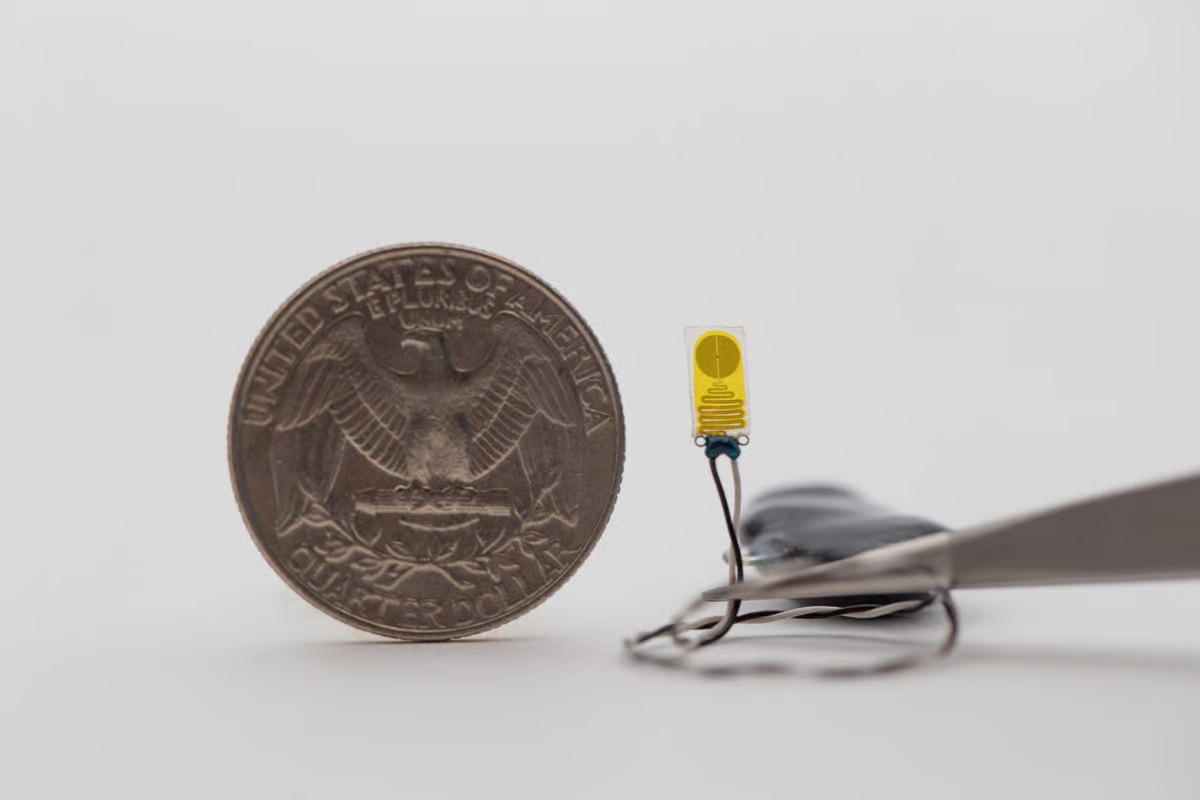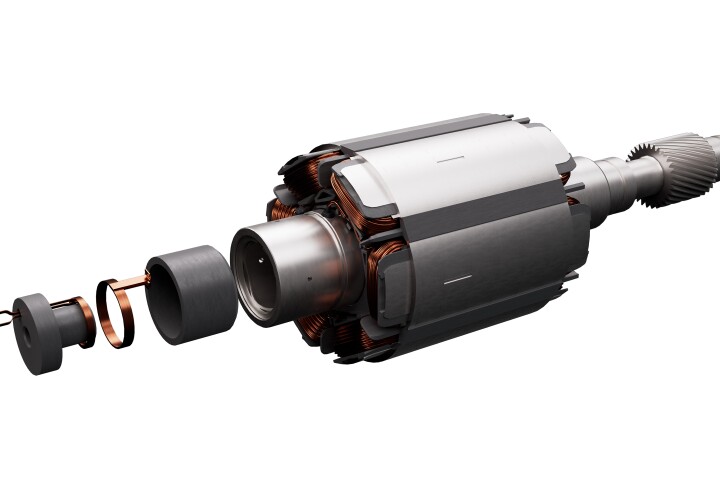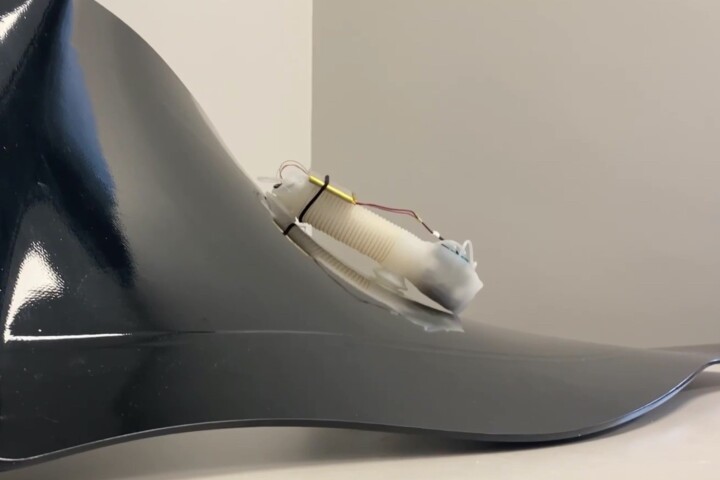 The entire sensor and connected electronics are smaller than a quarter. Northwestern University View gallery – 4 images
The entire sensor and connected electronics are smaller than a quarter. Northwestern University View gallery – 4 images
While a body can reject an organ even years after a transplant, buying the patient and clinicians as much time as possible to intervene can be the difference between restoring homeostasis and beginning the long and arduous transplant process again – if that’s even an option. And while the race is on to find a better source of donor kidneys, it’s a slow process. In the US, the current waitlist for a new kidney is three to five years.
So, naturally, being able to constantly monitor the health of a precious new kidney would be life-changing for patients.
This new monitoring device, which is just 0.3 cm x 0.7 cm and 220 microns thick, is designed to sit on the kidney, beneath its fibrous renal capsule layer that surrounds and protects the organ. The soft implant detects temperature changes linked to inflammation and other responses common in early rejection. If a change is detected, an alert is sent wirelessly to a nearby smartphone or tablet.
Because rejection often starts silently, this device could help alert the patient to crucial changes in the absence of telltale symptoms. And as a result of this, it can offer vital peace of mind for those who have their lives riding on the success of the transplant.
“I have noticed many of my patients feel constant anxiety – not knowing if their body is rejecting their transplanted organ or not,” said the study’s clinical lead Dr Lorenzo Gallon, a Northwestern Medicine transplant nephrologist. “They may have waited years for a transplant and then finally received one from a loved one or deceased donor. Then, they spend the rest of their lives worrying about the health of that organ. Our new device could offer some protection, and continuous monitoring could provide reassurance.”
There are more than 250,000 people in the US living with a kidney they were not born with, and the transplant itself is just one significant but small part in the journey. Currently, the health of the organ is monitored through blood tests tracking creatinine and blood urea nitrogen levels, but these can fluctuate for unrelated reasons and lead to false negatives and positives. Biopsy tests, which involve the insertion of a long needle to retrieve tissue from the organ are invasive and have an elevated risk of bleeding, infection, pain and damage to nearby tissues.
“The turnaround time can be quite long, and they are limited in monitoring frequencies and require off-site analysis,” Gallon said. “It might take four or five days to get results back. And those four or five days could be crucial in making a timely decision for the care of the patient.”
Looking for an alternative, the Northwestern researchers zoned in on temperature as a key biomarker of initial transplant rejection. Temperature increases usually accompany inflammation, which was something the scientists saw in the animal model. Temperature jumps of as much as 0.6 °C (1.08 °F) were accurate red flags, warning of imminent organ rejection events.
“Organ temperature fluctuates over a daily cycle under normal circumstances,” said first author Surabhi Madhvapathy, a Northwestern graduate student. “We observed abnormal higher frequency temperature variations occurring over periods of eight and 12 hours in cases of transplant rejection.”
The device has a highly sensitive thermometer, which can detect tiny temperature changes that are local to the kidney. It can also measure blood flow (but temperature proved more effective as an early warning system).
The soft sensor is connected to a small set of electronics that sits next to the organ; a coin cell battery powers the device and Bluetooth capabilities transfer data to nearby external smart devices.
“All electronic components are encased in a soft, biocompatible plastic that is gentle and flexible against the kidney’s delicate tissues,” Madhvapathy said. “The surgical insertion of the entire system, which is smaller than a quarter, is a quick and easy procedure.”
 The electronic system has a coin cell battery and Bluetooth. Northwestern University
The electronic system has a coin cell battery and Bluetooth. Northwestern University
Positioning it on the organ beneath the renal capsule allows for it to stay in place regardless of physical activity.
“The capsule keeps the device in good thermal contact with the underlying kidney,” Rogers said. “Bodies move, so there is a lot of motion to deal with. Even the kidney itself moves. And it’s soft tissue without good anchor points for sutures. These were daunting engineering challenges, but this device is a gentle, seamless interface that avoids risking damage to the organ.”
While this first-of-its-kind technology still needs larger studies and human trials, scientists are already working on improving the design to allow for recharging of its coin cell battery, so the device could last for life. The researchers also believe it has the potential to be adapted for monitoring other transplanted organs.
One of the scientists involved in the project, Dr. Joaquín Brieva, received a kidney transplant in September 2022 and is acutely aware of what such a real-time monitoring device would do to the quality of life of patients.
“Within two days of my transplant, my kidney function was back to normal,” said Brieva, who was not involved with the study. “But then you worry about the possibility of kidney rejection. That’s why you have these potent anti-rejection drugs and steroids. You’re walking a tightrope of anxiety about infections, complications from the drugs, various side effects and rejection of the kidney. You can manage some of that concern with medication adjustments, but kidney rejection remains prevalent. Your transplanted kidney is extremely precious.
“Having this device would be reassuring,” he said. “It can pick up any sudden changes in the kidney transplant and detect acute rejection, which currently gives no warning signs.”
The study was published in the journal Science. Check out the video below to see just how this device is designed to work.
–
Source: Northwestern University View gallery – 4 images
–
























